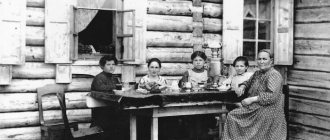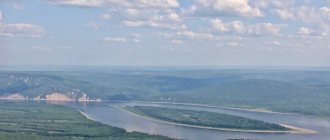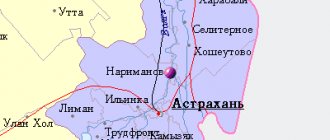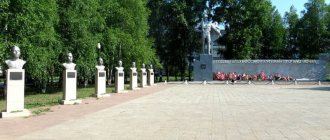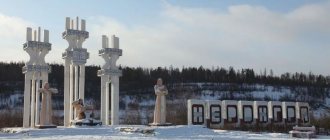General information about the Republic of Yakutia
Distinctive features .
The Republic of Sakha, or Yakutia, is the largest region in Russia. With an area of 3 million square meters. km, Yakutia today is the largest administrative-territorial entity in the world. The territory of Yakutia can accommodate five Frances or one Kazakhstan. But this is not the only feature of this unique region. Another peculiarity of Yakutia is that these vast territories are inhabited by barely anything - a little more than 950 thousand people. And although Yakutia is not a leader among regions with the lowest population density, the contrast between the size of the territory and the number of inhabitants is still amazing.
To move around Yakutia you need special transport...
The main wealth of Yakutia is its mineral resources. And the most valuable of them are diamonds and uranium. The Elkon uranium deposit is the largest in the country. It has reserves of 600 thousand tons of uranium. A is one of the most important players in the global diamond market. But if you dream of a diamond paradise, do not rush to pack your bags and go to Yakutia. Weigh the pros and cons. And think about it - why, given such a huge territory, is there such a small population in Yakutia?
So what prevents the settlement of the vast Yakut expanses? First of all, the climate. The entire territory of Yakutia belongs to the regions of the Far North. In many areas, the average temperature in January or December breaks the mark of minus forty below zero. It is in Yakutia that Oymyakon is located - the pole of cold of the Northern Hemisphere, where a temperature of −71°C was recorded. Short summers and long winters, when the temperature is below zero for 7-9 months a year, are truly hellish conditions that can scare away even the most desperate romantics.
Geographical location . The Republic of Sakha is part of the Far Eastern Federal District. But to tell the truth, geographically it belongs not so much to the Far East as to northeastern Siberia.
In the north it has an extensive coastline, washed by two seas of the Arctic Ocean - the Laptev Sea and the East Siberian Sea. In the east it borders with the Chukotka Autonomous Okrug and the Magadan Region, in the southeast - with the Khabarovsk Territory, in the south - with the Amur and Transbaikal Territories, in the southwest - with the Irkutsk Region, in the west - with the Krasnoyarsk Territory.
Most of it is occupied by dense taiga forests, and only in the northern, Arctic region is some diversity observed. But it is unlikely to please a lover of diverse flora and fauna. Arctic deserts, tundra and forest-tundra are the main natural zones of northern Yakutia, where reindeer, polar bears, seals and walruses reign.
One of the greatest rivers of Siberia, the Lena, flows through Yakutia. Its length is 4400 km. Its numerous tributaries form the vast basin of the Lena River, an area comparable to the size of Yakutia itself. Other significant rivers are the Aldan and Kolyma. Yakutia can be called a country not only of rivers, but also of lakes: there are more than 600 thousand lakes here, 10 of them have an area of more than 100 square meters. km.
Lena River - the majestic river of Siberia
Population. The indigenous population of the Sakha Republic are the Yakuts, who call themselves Sakha. This people is known for having bred a special breed of cows (Yakut cow) and dogs (Yakut Laika). Today, these born hunters and herders make up half of the population of Yakutia (48.67%). Russians are in second place (36.9%). In third place is another indigenous people - the Evenks (2.19%).
Yakut girl in national costume
The birth rate in Yakutia is almost twice as high as the mortality rate (17.6 people per 1000 population versus 9.3 people). Nevertheless, the population of the republic remains stable at around one million, plus or minus 50 thousand people. As of 2013, 955,580 people lived here. Of course, many of those who came here during the USSR are striving to leave the Sakha Republic and move to a place where the climate is better and there are more benefits of civilization.
Crime . In the Republic of Sakha, crime is all right. That is, it exists, its level is not so high as to sound the alarm. 36th place in the crime ranking of regions suggests that the crime level in Yakutia does not differ from the Russian average. Many crimes are committed while drunk. They drink a lot in Yakutia - some out of idleness, some out of despair.
The unemployment rate in Yakutia is quite high - almost 8%. It should be noted here that the republic’s economy is focused on mineral extraction. This is where the highest salaries are - 66 - 79 thousand. Those who are engaged in financial activities or science receive slightly less (about 60 thousand).
But the rest have a pretty hard time. For example, the average salary of fishermen is 12 thousand rubles, and those employed in agriculture are 13 thousand rubles. Who knows, maybe they are given wages in kind? One way or another, the average salary in Yakutia is 39.6 thousand rubles, which, although not small, is not such a big compensation for the harsh living conditions for the regions of the Far North, where permafrost reigns.
Kimberlite pipe "Mir" in Mirny
Property value. The average cost of a one-room apartment in Yakutsk is 3 million rubles. The price for two-room apartments starts from 3.5 million rubles and can reach 6 - 6.5 million rubles.
Climate. When talking about the climate of Yakutia, first of all, they highlight a significant temperature range - from +40°C in summer to −60°C in winter. Indeed, a feature of the Yakut climate is that it is sharply continental. Average daily temperatures here rise very quickly in spring and fall just as quickly in autumn. The most favorable climatic conditions are in the middle basin of the Lena River, where the duration of the frost-free period is as much as 95(!) days. Snow cover lasts 200-250 days a year. Winters in Yakutia are usually dry and with little snow. Peak precipitation occurs in February - March.
Aisen Nikolaev: The population of Yakutia is growing steadily
The population increased by almost 10 thousand people. For the first time in six years, the birth rate increased in 2022, with almost 40 percent of newborns born in large families. In addition, for the first time in 30 years, the migration decline in the population was replaced by an increase.
“The profound transformations we have faced in recent years offer valuable lessons. It is not the indicators of economic growth that have acquired the highest degree of importance, but the ultimate issues of the well-being of the person himself,” emphasizes the head of the republic, Aisen Nikolaev. — At the same time, in the work of government bodies of the Republic of Sakha (Yakutia), it is necessary to note the priority of two areas. The first is to protect the life and health of the residents of the republic and counter the spread of the new coronavirus infection. Secondly, restoring the rate of economic growth, employment and income of Yakut residents, supporting entrepreneurship and business activity in the industries most affected by the pandemic.
Much has already been achieved in the republic in the field of healthcare. The infant mortality rate has fallen to historic lows, falling to 4.8 per 1,000 live births. Despite the mobilization of medicine to fight coronavirus, all tasks under the national project “Healthcare” have been completed. In 2018, a Perinatal Center was opened in Yakutsk. During 2018-2020, 32 first aid stations (FAPs), medical outpatient clinics and general practitioner offices, as well as a hospital with a clinic for 180 visits were commissioned in Batagay. Cardiology and oncology centers are being built at a faster pace. The digitalization of healthcare has undergone active development during the pandemic.
— The coming decade in the republic has been declared the Decade of Health. Over these 10 years, Yakutia should become a region with the highest life expectancy, setting new health care standards, says Aisen Nikolaev.
In Yakutia, there was an increase in per capita cash income: in 2018 - by 6.2 percent compared to the previous year, in 2019 - by 5.7. In the most difficult year of 2020, real disposable cash income amounted to 97.7 percent (the average for the Russian Federation is 96.5).
Every year in the republic all obligations regarding social benefits and payments are fulfilled in full. 13.5 billion rubles were allocated for social support measures in 2022, and 9.6 billion in 2020. 160 thousand families with children and citizens left without work took advantage of assistance in the form of payments and benefits. 13 thousand entrepreneurs received various types of support and benefits. One of the tools for getting low-income citizens out of a difficult life situation is to provide them with government assistance based on a social contract, which has already helped 6,601 families.
“Under the conditions of fairly strict restrictions, a serious crisis in industry markets, we did not allow the shutdown of industrial and life-supporting enterprises in the republic, mass layoffs and a significant decline in the incomes of Yakut residents,” states the head of Yakutia. “Under the most difficult conditions of restrictions and economic slowdown, we managed to lift an additional 3,100 residents of the republic out of poverty. There is a positive trend in the fight against poverty: from 19.5 percent in 2022 to 17.4 at the end of 2020. Behind these dry figures is an increase in the level and quality of life, the well-being of 20 thousand Yakut residents.
Priority development territories made a significant contribution to increasing employment, and therefore the standard of living of Yakut residents; in 2022 alone, 898 jobs were created by residents of priority development areas. Under the “Local Personnel in Industry” project, more than 1,340 people were trained in blue-collar jobs; in total, over 22 thousand residents of the republic were employed in large enterprises under the project in 2019-2021.
Last year, every fifth square meter of housing introduced in the Far Eastern Federal District was Yakut. 530 thousand square meters were delivered, or 102.7 percent of the planned amount. The housing commissioning plan is traditionally exceeded: in 2022, 530.8 thousand square meters were built, or 102.1 percent of the target.
In the republic, housing conditions are annually improved by citizens of preferential categories - those leaving the Far North, orphans and young families. In 2022, thanks to state support, more than 1,100 families received new housing, in 2019 - 749, in 2020 - 1,209. As part of the program for relocating citizens from emergency housing stock, 1,335 people became new residents in 2022 (168 percent of the plan), in 2020 - 6317.
“The activities of the social sphere, especially the education system, in 2022 and 2022 during the pandemic proved how timely and effective our focus on digital transformation was,” says Aisen Nikolaev. — In general, in 2020 we strengthened our leadership in the export of IT services in the Far East. Thus, the revenue of IT Park residents increased by more than 60 percent. In the most difficult conditions, 2,307 kilometers of fiber-optic communication lines were built. 36 settlements of the republic are connected to high-speed Internet, where the cost of a conventional 1 Mbit/s has decreased on average by five times. In recent years, the relevance of modernizing all spheres of the economy and social life based on new technologies has become firmly established in Yakutia.
The head of the region is confident: the key task of Yakutia is to find and test solutions that will work not only here, but will also serve as a positive example for others.
Cities of Yakutia
Yakutsk (286 thousand people) is the capital of the Sakha Republic. Founded by the Cossacks in 1632 as the Lensky (Yakut) fort. Since then, it has become the center of the Yakut Cossacks and the main Russian base in northeastern Siberia.
Today Yakutsk is the third largest city in the Far Eastern Federal District. People from all the villages of the vast Yakutia come here in search of civilization, and local residents, primarily Russian speakers, strive to leave this city and move to the capital or somewhere near it. Despite good infrastructure, the presence of working enterprises, primarily the fuel and energy complex, and a lot of money, Yakutsk remained a lost city in the Siberian wilderness.
One of the office buildings in Yakutsk
Neryungri (60 thousand people) is the second largest city in Yakutia. Located in the very south of the republic. It was founded relatively recently - in 1975. But back in the 17th century, the first gold mines were discovered here. Now very valuable and rare coking coal is mined here, mainly for export.
Mirny (35 thousand people) is the diamond capital of Russia. Founded in 1955 next to the Mir kimberlite pipe discovered here. Diamonds are mined here by open-pit mining, and the diamond quarry, which goes 1,200 meters deep, is one of the largest in the world. This is where the diamond industry is located, which has invested a lot in the infrastructure of this city.
